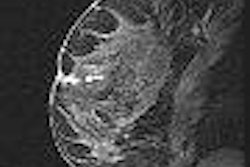For male mammography patients, it's bad enough when their physicians suspect breast cancer and send them for mammograms. And once they arrive for their appointments, the embarrassment and stress only make the situation worse.
Male patients are often greeted with pink medical history forms that ask them when they had their last menstrual cycle and a pink robe. Sometimes they are even mistakenly referred to as "Ms." when called in from the waiting room for their exams, said Kim Veasey, director of Breast Care Center at Memorial Hermann Southwest Hospital in Houston.
The situation rarely improves in the exam room. In addition to comments from techs that they "don't handle too many men," the exam itself can be difficult, she said. Men typically have less breast tissue and may in fact be muscular, which can make positioning complicated. Radiologic technologists often try to burn through muscle to get an image of the breast. This usually results in a lower-quality image, and the patient may be referred for an ultrasound for further imaging, Veasey said.
"We really do make (men) feel like second-class citizens," she said.
Male patients are enough of a presence that most facilities should consider taking action to ensure that they are comfortable and that image quality is high. Each year approximately 215,000 people are diagnosed with breast cancer; 1,450 will be men -- 450 of whom will die from the disease.
"I was at a meeting with between 250 and 300 techs, and every one of them or almost every one of them had performed a male mammogram," says Veasey.
Easy fixes
There are simple steps you can take to make your male patients feel more comfortable. Providing alternatives to the pink robes and forms, and drawing up a separate set of medical history and registration forms to give to male patients are good starts.
In addition, staff should be sensitive to these clients. Men are often not only scared that they might have cancer, but they are also embarrassed to be at a predominantly female facility, and will walk out if forced to wait too long, Veasey said.
Positioning
Special considerations for male patients shouldn't stop at the waiting room. Technologists should also learn positioning techniques to make exams go more smoothly and produce higher-quality images.
Although male breast cancer may conjure images of older men for many people, a large portion of male mammogram patients are as young as 20, Veasey said.
For example, steroid use can raise a person's risk of breast cancer; so many men who need mammograms are not only young, but muscular. Veasey said at one time she encountered three men, each in his 20s, and they all worked out at the same gym. All of them had taken the same steroids and were diagnosed with terminal cancer.
Positioning more muscular patients requires a different positioning technique. The key is to move back the pectoralis muscle to obtain a better view, Veasey said. This is similar to the positioning technique you would use to image an implant patient, she explained.
"Most people probably haven't seen it done, but our doctors love it," Veasey said. "By moving the muscle, you will be able to get a clearer image."
By Kelly Bilodeau
AuntMinnie.com contributing writer
August 18, 2005
This article originally appeared in the "Mammography Regulation and Reimbursement Report," a monthly newsletter designed specifically for mammographic technologists and their supervisors. It's a 12-page resource published by HC Pro that offers ideas for better practice management from peers, billing tips, MQSA regulatory updates and guidance, and business ideas related to breast imaging.
Related Reading
A guide to digital and soft-copy mammography, July 21, 2005
PET mammography unit shows promise for DCIS, June 22, 2005
RT bears burden of QA failure at PA mammo clinic, June 9, 2005
PA mammo clinic fails QA, must pay for re-screens, June 9, 2005
IOM advocates more monitoring of ailing mammo services, May 27, 2005
Copyright © 2005 HC Pro



















